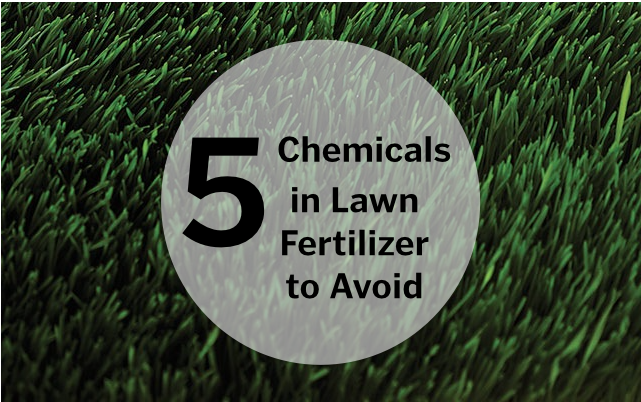Lawn chemicals are designed to kill weeds and bugs. But they can harm people, too, which is why so many communities are banning or minimizing their use. According to BeyondPesticides.org, suburban lawns and gardens receive more pesticide applications per acre (3.2-9.8 lbs) than agriculture (2.7 lbs per acre on average). That’s not even the bad news. According to their site, “Of 30 commonly used lawn pesticides, 19 have studies pointing toward carcinogens, 13 are linked with birth defects, 21 with reproductive effects, 15 with neurotoxicity, 26 with liver or kidney damage, 27 are sensitizers and/or irritants, and 11 have the potential to disrupt the endocrine (hormonal) system.”
Wildlife are at risk, too. Fifteen million birds are estimated to die each year from pesticide contamination, reports the Poughkeepsie Journal.
If you want to have a lawn but avoid dangerous chemicals, read the label on the fertilizer bag before you buy. Look for these chemicals of greatest concern:
Bifenthrin — This is the key ingredient in many grub- and insect-control products. It’s listed by the U.S. Environmental Protection Agency as a possible carcinogen and is toxic to fish. It is already banned in several counties in southern New York.
2,4-dichlorophenoxy acetic acid, or 2,4-D —This weed killer is linked in some studies to increased cancer risk (though it’s not classified as a carcinogen by the EPA).
Glyphosate — Glyphosate is the active ingredient in Monsanto’s RoundUp. It is also used to pretreat seeds as a way to inoculate them against pests and disease. Because it is used so widely, it is inevitably showing up in our air and water. The affects on human health could be serious. The Pesticide Action Network says that glyphosate can “activate the estrogen receptor in a breast cancer cell line, which means it may be able to mimic the function of the key sex hormone estrogen.” Research also shows it could deform the heads in developing frog and chicken embryos.
Atrazine (1,2) — This herbicide is used to control broadleaf weeds. It is one of the most widely used herbicides in the U.S., but was banned by the European Union in 2004, when the EU found groundwater levels exceeding the limits set by regulators. Studies suggest it is an endocrine disruptor, which means that it could alter people’s natural hormonal system.
Carbaryl — This chemical is used primarily as an insecticide. It is sold under the brand name Sevin. While it kills mosquitoes, it also targets honeybees, whose populations are under siege nationwide. Carbaryl is illegal to use in the United Kingdom, Germany, and Sweden, but it’s still applied to more than 100 crops in the U.S. It is often produced using the chemical compound methyl isocyanate (MIC). A leak of MIC used to produce carbaryl caused the Bhopal disaster in India, a catastrophe that led to thousands of deaths and more than 500,000 injuries.
In place of these and other toxic chemicals, use organic means to control pests. Beneficial insects and organic fungicides can keep pests and disease under control. It’s also advised to plant native grasses that resist fungus. Corn gluten is a popular organic option to control weeds. Get additional suggestions from your lawn and garden center and your local county extension agency.
Ultimately, the best strategy may be to replace lawns with ground covers, gardens, decorative stones, wood chips, and other materials that require no fertilizers.
This article was republished with the permission of Care2 and was written by Diane MacEachern.
Related Content From Care2
Strategies to Beat Back the Work Blues (Infographic) by Healthy Living Editors
You Are Covered in Bacteria (and that’s a good thing!) by Becky Striepe
11 Green Hacks to Stay Cool This Summer by Jordyn Cormier




This Post Has 0 Comments